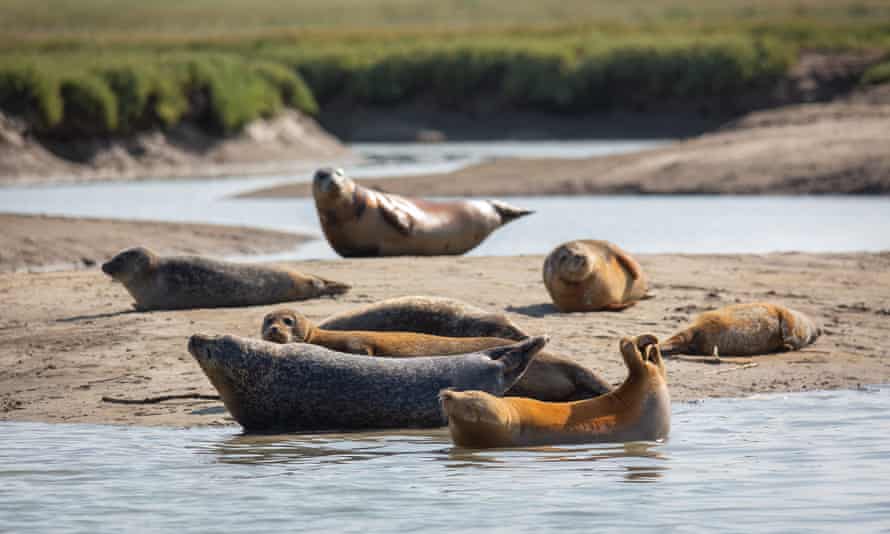River of life: zoo’s yearly count finds seals thriving on Thames
Hundreds of dozing seals show how much cleaner the river is since it was declared dead in the 1950s

Last modified on Mon 6 Sep 2021 09.21 EDT
“This is a sushi conveyor belt,” says the boat’s skipper, Stuart Barnes, as we watch the customers, dozens of harbour seals slumbering on sandbanks at the mouth of the Thames estuary, a 15-minute ride from Ramsgate marina.
August is moulting season, when seals shed their coats and grow new ones, spending much of their day on the sandbanks as a result. This makes it a good time for scientists to count them, with the Zoological Society of London (ZSL) running its three-day annual seal survey, using boats and a specially chartered light aircraft to get a view from above.
The results of the Greater Thames area survey, announced today, reveal there were 574 harbour seals and 685 grey seals spotted on the sandbanks and creeks downstream from London, stretching from Deal in Kent to Felixstowe in Suffolk. Studies suggest that at this time of year nearly a quarter of grey seals and three-quarters of harbour seals are out on land. This indicates populations of about 2,800 grey and 800 harbour seals in the estuary.
“It’s a really fantastic story for the Thames – it really demonstrates the recovery that the estuary has gone through,” says Thea Cox, a ZSL conservation biologist. “We’ve come a long way since the 50s.”
In the 1950s, the Thames was declared biologically dead, and the Guardian reported in 1959: “The tidal reaches of the Thames constitute a badly managed open sewer.” But now seals can enjoy a varied diet of more than 100 species of fish, including trout, plaice and flounder. Seals are territorial, and some of them have been here for five or six years.
“This is basically an all-inclusive holiday for them,” says Barnes, who has been doing tours for a decade, and talks with warmth about their different characters, including an albino seal he likens to a “funny old gentleman” and another who seems to be constantly showing off.
The Thames might look dirty, but it is brown because tides of up to seven metres churn up mud from the ground. The estuary is a rich mix of fresh and saltwater, and the presence of keystone species is proof there is a healthy food web in the murky waters. The critically endangered European eel, dover sole and the short-snouted seahorse are also found here.
The seals lie relatively still as we cruise by, still except for the occasional swivel of the head or wisp of a flipper, unbothered by a boat of paparazzi pointing cameras at them. Despite looking ill-suited to life on land, they spend up to 12 hours a day dozing on the warm sand and then flopping into the brackish water to feed.
They are agile swimmers, mixing freely with continental populations. In 2019, in the first comprehensive count of seal pups born on the Thames, researchers recorded 138. Estimates for that year suggest there were 3,243 grey seals and 932 harbour seals in the estuary. The seal survey did not happen last year, due to the pandemic.

Since the ZSL count began in 2013, the seal population has grown steadily but, after reaching more than 1,000 in 2017, there has been a slight decline in harbour seals. Many factors could explain this, including the proportion of seals out at sea when the count takes place. “But for us, the importance is in the long-term picture,” says Cox.
“We have to remember when we do these surveys that it’s a snapshot of a few days in the year, and there are also environmental factors at play,” she says. “It’s about doing surveys on a regular basis, seeing what happens over several years, and monitoring those trends.”
Risks include controversial plans to dredge the 10-mile-long Goodwin Sands, off Sandwich Bay on the Kent coast, which is a popular sandbank for seals and also a marine protected area. There are also concerns about the return of the phocine distemper virus that wiped out thousands of seals in 1988 and 2002.
The UK is home to 40% of the world’s grey seals and more than 33,000 harbour seals – which are the only ones to breed here – amounting to about 5% of the global population.
For the moment, it seems all is well with these seals, and after a few hours of watching them, we motor back to the harbour, envious of their seemingly relaxed lifestyle. “Every day is a Sunday for this lot,” someone comments.
Find more age of extinction coverage here, and follow biodiversity reporters Phoebe Weston and Patrick Greenfield on Twitter for all the latest news and features
